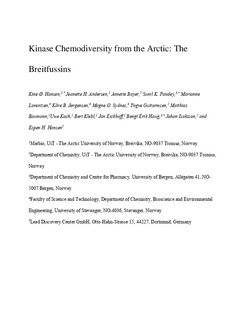| dc.contributor.author | Østnes Hansen, Kine | |
| dc.contributor.author | Andersen, Jeanette hammer | |
| dc.contributor.author | Bayer, Annette | |
| dc.contributor.author | Pandey, Sunil Kumar | |
| dc.contributor.author | Lorentzen, Marianne | |
| dc.contributor.author | Jørgensen, Kåre Bredeli | |
| dc.contributor.author | Sydnes, Magne Olav | |
| dc.contributor.author | Guttormsen, Yngve | |
| dc.contributor.author | Baumann, Matthias | |
| dc.contributor.author | Koch, Uwe | |
| dc.contributor.author | Klebl, Bert | |
| dc.contributor.author | Eickhoff, Jan | |
| dc.contributor.author | Haug, Bengt Erik | |
| dc.contributor.author | Isaksson, Johan | |
| dc.contributor.author | Hansen, Espen | |
| dc.coverage.spatial | the Arctic | nb_NO |
| dc.date.accessioned | 2020-02-13T09:44:12Z | |
| dc.date.available | 2020-02-13T09:44:12Z | |
| dc.date.created | 2019-11-12T21:25:55Z | |
| dc.date.issued | 2019-10 | |
| dc.identifier.citation | Hansen, K.:., Andersen, J.H., Bayer, A. (2019) In this work, we demonstrate that the indole-oxazole-pyrrole framework of the breitfussin family of natural products is a promising scaffold for kinase inhibition. Six new halogenated natural products, breitfussin C–H (3 – 8) were isolated and characterized from the Arctic, marine hydrozoan Thuiaria breitfussi. The structures of two of the new natural products were also confirmed by total synthesis. Two of the breitfussins (3 and 4) were found to selectively inhibit the survival of several cancer cell lines, with the lowest IC50 value of 340 nM measured against the drug-resistant triple negative breast cancer cell line MDA-MB-468, while leaving the majority of the tested cell lines not or significantly less affected. When tested against panels of protein kinases, 3 gave IC50 and Kd values as low as 200 and 390 nM against the PIM1 and DRAK1 kinases, respectively. The activity was confirmed to be mediated through ATP competitive binding in the ATP binding pocket of the kinases. Furthermore, evaluation of potential off-target and toxicological effects, as well as relevant in vitro ADME parameters for 3 revealed that the breitfussin scaffold holds promise for the development of selective kinase inhibitors. Journal of Medicinal Chemistry, 62(22), pp. 10167-10181. | nb_NO |
| dc.identifier.issn | 0022-2623 | |
| dc.identifier.uri | http://hdl.handle.net/11250/2641484 | |
| dc.description.abstract | In this work, we demonstrate that the indole-oxazole-pyrrole framework of the breitfussin family of natural products is a promising scaffold for kinase inhibition. Six new halogenated natural products, breitfussin C–H (3 – 8) were isolated and characterized from the Arctic, marine hydrozoan Thuiaria breitfussi. The structures of two of the new natural products were also confirmed by total synthesis. Two of the breitfussins (3 and 4) were found to selectively inhibit the survival of several cancer cell lines, with the lowest IC50 value of 340 nM measured against the drug-resistant triple negative breast cancer cell line MDA-MB-468, while leaving the majority of the tested cell lines not or significantly less affected. When tested against panels of protein kinases, 3 gave IC50 and Kd values as low as 200 and 390 nM against the PIM1 and DRAK1 kinases, respectively. The activity was confirmed to be mediated through ATP competitive binding in the ATP binding pocket of the kinases. Furthermore, evaluation of potential off-target and toxicological effects, as well as relevant in vitro ADME parameters for 3 revealed that the breitfussin scaffold holds promise for the development of selective kinase inhibitors. | nb_NO |
| dc.language.iso | eng | nb_NO |
| dc.publisher | American Chemical Society | nb_NO |
| dc.subject | peptider | nb_NO |
| dc.subject | karbon | nb_NO |
| dc.subject | kjemisk struktur | nb_NO |
| dc.title | Kinase chemodiversity from the Arctic: the breitfussins | nb_NO |
| dc.type | Journal article | nb_NO |
| dc.type | Peer reviewed | nb_NO |
| dc.description.version | acceptedVersion | nb_NO |
| dc.rights.holder | Copyright © 2019 American Chemical Society | nb_NO |
| dc.subject.nsi | VDP::Mathematics and natural science: 400::Chemistry: 440 | nb_NO |
| dc.source.pagenumber | 10167-10181 | nb_NO |
| dc.source.volume | 62 | nb_NO |
| dc.source.journal | Journal of Medicinal Chemistry | nb_NO |
| dc.source.issue | 22 | nb_NO |
| dc.identifier.doi | 10.1021/acs.jmedchem.9b01006 | |
| dc.identifier.cristin | 1746797 | |
| dc.relation.project | Norges forskningsråd: 244264 | nb_NO |
| dc.relation.project | Norges forskningsråd: 174885 | nb_NO |
| cristin.unitcode | 217,8,10,0 | |
| cristin.unitname | Institutt for kjemi, biovitenskap og miljøteknologi | |
| cristin.ispublished | true | |
| cristin.fulltext | postprint | |
| cristin.qualitycode | 2 | |
